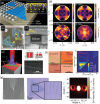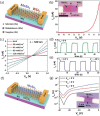Tailored Growth of Transition Metal Dichalcogenides' Monolayers by Chemical Vapor Deposition
- PMID: 39487631
- PMCID: PMC12272037
- DOI: 10.1002/smll.202403089
Tailored Growth of Transition Metal Dichalcogenides' Monolayers by Chemical Vapor Deposition
Abstract
Here, results on the tailored growth of monolayers (MLs) of transition metal dichalcogenides (TMDs) are presented using chemical vapor deposition (CVD) techniques. To enable reproducible growth, the flow of chalcogen precursors is controlled by Knudsen cells providing an advantage in comparison to the commonly used open crucible techniques. It is demonstrated that TMD MLs can be grown by CVD on large scale with structural, and therefore electronic, photonic and optoelectronic properties similar to TMD MLs are obtained by exfoliating bulk crystals. It is shown that besides the growth of the "standard" TMD MLs also the growth of MLs that are not available by the exfoliation is possible including examples like lateral TMD1-TMD2 ML heterostructures and Janus TMDs. Moreover, the CVD technique enables the growth of TMD MLs on various 3D substrates on large scale and with high quality. The intrinsic properties of the grown MLs are analyzed by complementary microscopy and spectroscopy techniques down to the nanoscale with a particular focus on the influence of structural defects. Their functional properties are studied in devices including field-effect transistors, photodetectors, wave guides and excitonic diodes. Finally, an outlook of the developed methodology in both applied and fundamental research is given.
Keywords: 2D materials; chemical vapor deposition; devices; structural properties; transition vapor dichalogenides.
© 2024 The Author(s). Small published by Wiley‐VCH GmbH.
Conflict of interest statement
The authors declare no conflict of interest.
Figures
























Similar articles
-
Management of urinary stones by experts in stone disease (ESD 2025).Arch Ital Urol Androl. 2025 Jun 30;97(2):14085. doi: 10.4081/aiua.2025.14085. Epub 2025 Jun 30. Arch Ital Urol Androl. 2025. PMID: 40583613 Review.
-
Resonant Raman Scattering Study of Strain and Defects in Chemical Vapor Deposition Grown MoS2 Monolayers.Small. 2025 Jul;21(28):e2310685. doi: 10.1002/smll.202310685. Epub 2024 Apr 1. Small. 2025. PMID: 38558523 Free PMC article.
-
Short-Term Memory Impairment.2024 Jun 8. In: StatPearls [Internet]. Treasure Island (FL): StatPearls Publishing; 2025 Jan–. 2024 Jun 8. In: StatPearls [Internet]. Treasure Island (FL): StatPearls Publishing; 2025 Jan–. PMID: 31424720 Free Books & Documents.
-
Two-Step Conversion of Metal and Metal Oxide Precursor Films to 2D Transition Metal Dichalcogenides and Heterostructures.Small. 2025 Jul;21(28):e2400463. doi: 10.1002/smll.202400463. Epub 2024 May 11. Small. 2025. PMID: 38733217 Review.
-
Orientation-Controlled van der Waals Epitaxy of MoSe2 Monolayers on Graphene by MOCVD.ACS Appl Mater Interfaces. 2025 Jun 18;17(24):35928-35937. doi: 10.1021/acsami.5c05035. Epub 2025 Jun 4. ACS Appl Mater Interfaces. 2025. PMID: 40464078
Cited by
-
Sensitive Detection of Specific Volatile Organic Compounds by Functionalized Transition Metal Dichalcogenide Monolayers.Langmuir. 2025 Aug 26;41(33):22455-22470. doi: 10.1021/acs.langmuir.5c02852. Epub 2025 Aug 12. Langmuir. 2025. PMID: 40795109 Free PMC article.
References
-
- Manzeli S., Ovchinnikov D., Pasquier D., Yazyev O. V., Kis A., Nat. Rev. Mater. 2017, 2, 17033.
-
- Wang Q. H., Kalantar‐Zadeh K., Kis A., Coleman J. N., Strano M. S., Nat. Nanotechnol. 2012, 7, 699. - PubMed
-
- Chhowalla M., Shin H. S., Eda G., Li L.‐J., Loh K. P., Zhang H., Nat. Chem. 2013, 5, 263. - PubMed
-
- Mak K. F., Lee C., Hone J., Shan J., Heinz T. F., Phys. Rev. Lett. 2010, 105, 136805. - PubMed
-
- Ellis J. K., Lucero M. J., Scuseria G. E., Appl. Phys. Lett. 2011, 99, 261908.
Publication types
Grants and funding
LinkOut - more resources
Full Text Sources

